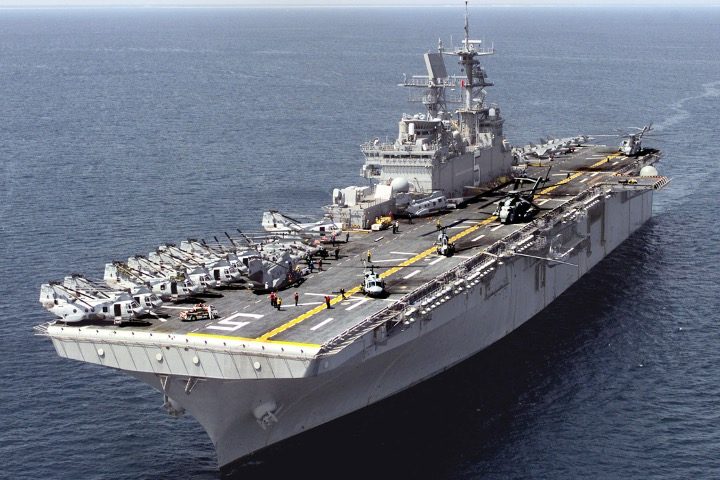
On August 6, the U.S. military mobilized more than 3,000 troops and additional naval assets to the Middle East to “deter” Iranian forces, after Washington slammed Tehran for harassing commercial vessels and other “destabilizing” actions.
The U.S. Navy’s 5th Fleet made the announcement regarding the troop deployments on Monday, pointing out that more than 3,000 Marines and sailors had arrived in the Red Sea aboard an amphibious assault ship and a dock-landing vessel the day before.
“These units add significant operational flexibility and capability as we work alongside international partners to deter destabilizing activity and de-escalate regional tensions caused by Iran’s harassment and seizures of merchant vessels earlier this year,” 5th Fleet spokesman Commander Tim Hawkins revealed in a statement to The Hill. Hawkins said that the recent troop deployments indicated America’s “strong, unwavering commitment to regional maritime security.” The arrival formed part of a pre-announced military deployment, the U.S. Naval Central Forces Command claimed.
The Navy revealed that the USS Bataan, the amphibious assault ship sent in the latest deployment, contained additional air assets, “as well as more U.S. Marines and Sailors, providing greater flexibility and maritime capability to the US 5th Fleet.”
Without providing details about the systems on board, the military stated that the ship can carry more than two dozen rotary-wing and fixed-wing aircraft, including the Osprey tilt-rotor aircraft and AV-8B Harrier attack jets, apart from a number of landing craft. The smaller USS Carter Hall, a docking ship, will function as a support vessel for operations involving landings or amphibious attacks.
Based on statements from the U.S. Central Command, Defense Secretary Lloyd Austin decreed the deployments in July “in response to recent attempts by Iran to seize commercial ships” in the region. While America has repeatedly lambasted Iran for such seizures since 2019, such accusations have increased in recent months, with the Pentagon declaring various new troop mobilizations in that time.
Before the Bataan arrived in the Red Sea, coming from the Mediterranean Sea through the Suez Canal, Iranian state media reported that the country’s Navy had been stocked with new weapons, including reconnaissance and combat drones, electronic warfare equipment, truck-mounted missile launchers, and hundreds of cruise and ballistic missiles. Alluding to the new capabilities, Navy Commander Alireza Tangsiri declared that the systems would enhance accuracy and permit longer-range strikes.
Iran has been a long-standing critic of the United States for the latter’s “warmongering” and provocative actions with American military activities around the Persian Gulf. For instance, Iranian Rear Admiral Ramazan Zirrahi claimed U.S. warplanes had unsuccessfully tried to help a commercial ship accused of smuggling to escape last month.
“On July 6, IRGC [Islamic Revolutionary Guard Corps] Navy personnel were inspecting a ship named NADA 2 that was involved in smuggling Iranian oil and gas in the Persian Gulf, which the Americans sought to prevent through a series of risky and unprofessional actions,” the admiral told the Tasnim news agency.
Zirrahi is at the helm of the second naval district of the IRGC, headquartered in Bushehr. He told Tasnim that his men intercepted radio traffic between the ship’s captain and the “American command and control center in the region.” The 5th Fleet is located in Bahrain.
According to Zirrahi, the Americans allegedly told the captain to turn off the ship’s engines and wait to be rescued. The Iranian admiral claimed that the 5th Fleet then sent two A-10 ground attack planes, a P-8A Poseidon spy plane, two Black Hawk helicopters, an MQ-9 drone and “patrol vessels” to the site, but could not stop the ship from being seized.
Since 2019, Iran has seized several ships in the Persian Gulf, supposedly to pressure the West over negotiations over its failed nuclear deal with world powers. Bilateral ties chilled even further following the Trump administration’s decision to pull out from Iran’s 2015 nuclear agreement, according to reports from the Associated Press (AP).
In mid-July, the U.S. Defense Department announced that it would send F-35 and F-16 fighter jets to the Middle East alongside a guided-missile destroyer to “defend US interests and safeguard freedom of navigation.” The announcement came after another naval deployment earlier this year.
Washington maintains that Iran is “a clear threat to regional maritime security and the global economy,” and has slammed Tehran for having “harassed, attacked or seized nearly 20 internationally flagged merchant vessels” since 2021, labeling the actions as “destabilizing.”
During one week between late April and early May, Iran seized two oil tankers registered in Panama and the Marshall Islands, sparking an outcry from the U.S. Navy.
“Iran’s unwarranted, irresponsible and unlawful seizure and harassment of merchant vessels must stop,” Vice Admiral Brad Cooper, who leads the 5th Fleet naval forces, said in a statement.
U.S. Central Command (CENTCOM), which monitors operations in the Middle East, indicated that it has been “working with regional allies and partners to increase the rotation of ships and aircraft patrolling in and around the Strait of Hormuz.”
While the Pentagon offered few details about what the stepped-up military presence would include, it said U.S. warships will stage “heightened patrols” around the gulf. A CENTCOM spokesperson pointed out that an eventual decision would be reached after “consulting with our allies” to be “consistent with the collective desire to ensure the safety and freedom of navigation for all nations.”
Located between Iran, the United Arab Emirates, and Oman, the Strait of Hormuz functions as a transit hub for about one-fifth of the world’s oil products annually.



